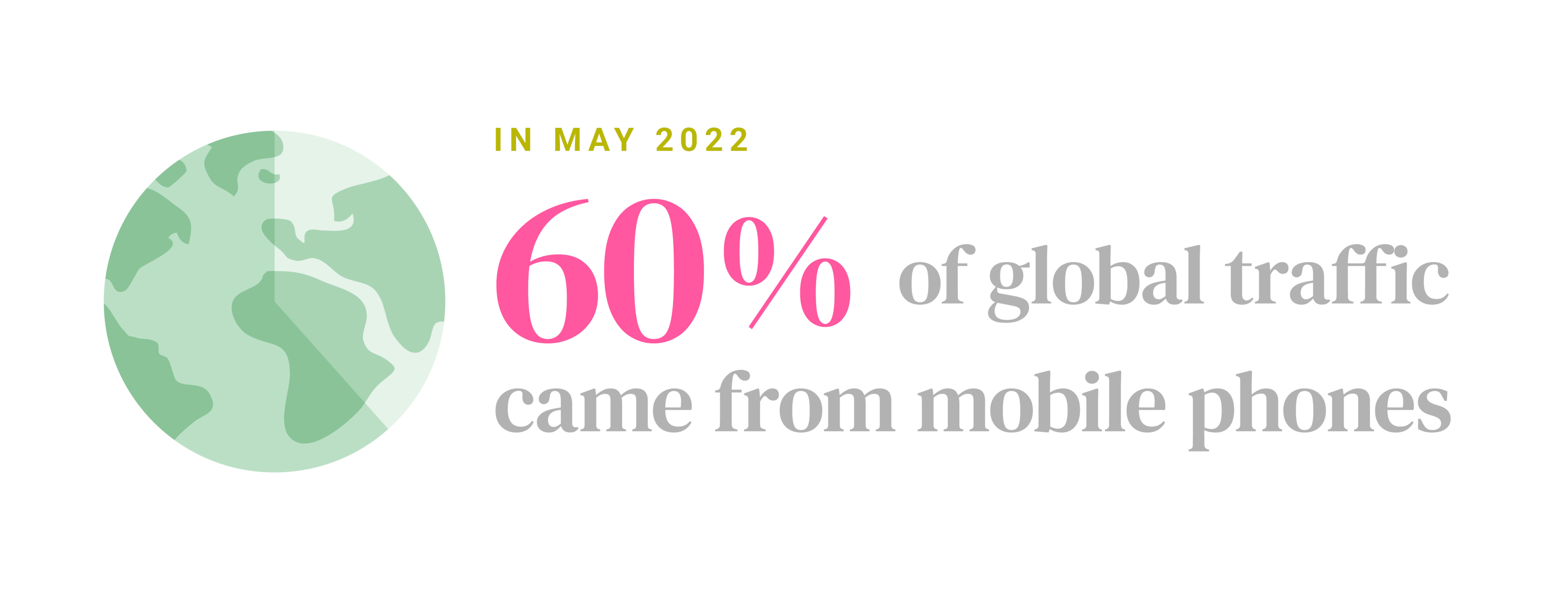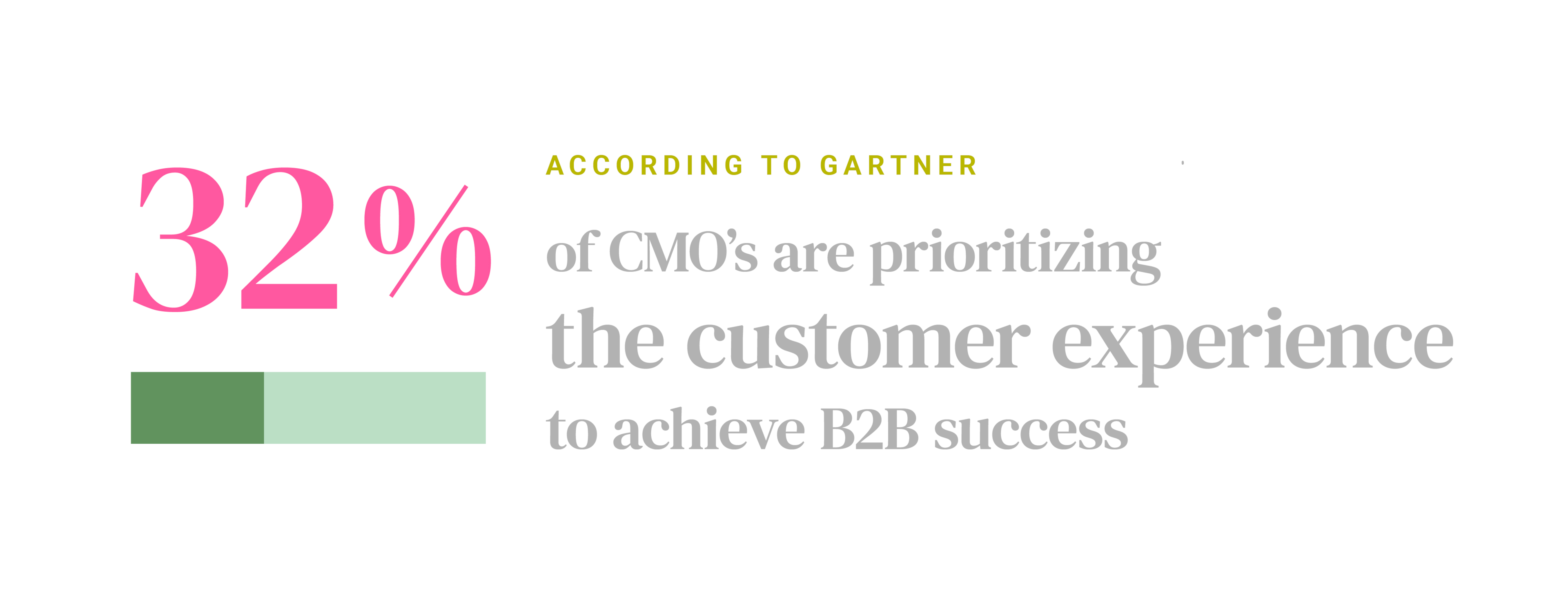This article was supposed to be about B2B marketing trends. But, the truth is, what we discuss here are more than just trends, they are essentials to a brand and marketing strategy. These approaches are fundamentals you need to build into your business before launching. In fact, you're probably incorporating them into your practices already. So, why mention them? Because when we're in the hustle of business, we benefit from stopping occasionally and reflecting on what we're doing and why we're doing it. And, if you aren't pursuing these practices and marketing efforts, you can ask yourself, why aren't you?
The Best Mobile Experience
You cannot go anywhere without seeing the overwhelming majority of people hunched forward, glued to their phone screens, like a bunch of aimless zombies. Everybody is on their phones 24/7.

In May 2022, almost 60 percent of global web traffic came from mobile phones. People aren't just texting with their friends or ordering food: they're working on their phones, B2B decision makers included. If your website or apps aren't optimized for a small screen, you're leaving a lot of revenue, not to mention goodwill, on the table.
The B2B purchasing journey can be long, with sophisticated buyers who want to be well-informed before they make a decision. Statistics show that mobile engagement can speed the purchasing process by as much as 20 percent. What's more, an engaging experience generates loyalty and repeat business.
What to do? Offer your B2B customers the same frictionless ease of use they've come to expect from mobile consumer shopping on best-in-class sites. Think click-to-call links, vertical layouts with minimal text, and easy order tracking features. Which makes a good segue into the next fundamental trend of modern B2B marketing.
Design For Humans, Not Customers
Marketers and product developers love to pontificate about the terms human-centered design, user-centered design, and customer-centric design. People often think these are the same personas (another term marketing teams and UX designers use). But a purchase decision maker may not be a user. The VP of IT may have input into a technical writer's choice of formatting tool, but the VP isn’t going to sit with the tool writing documentation. Which persona’s messaging do you optimize?

There’s no doubt you need to make the customer experience frictionless and efficient. Especially since the competition—32% of CMOs, according to Gartner—prioritize the customer experience to achieve B2B success. And, the data you glean from their mobile experiences with your marketing strategies can help you customize messaging.
More than that, especially since the pandemic, you need to stop thinking about your customers as customers and start thinking about them as humans, including your business-to-business customers. Customer-centered design focuses on the sales experience: true human-centered marketing seeks to understand and empathize with people's values, expectations, and goals.
The pandemic provided many examples of companies going beyond the pitch to relate to people. Diverse organizations offered free online content, such as SAP with technical courses, and Stanford University data science lectures. Companies like Pfizer have gone so far as to redesign logos to reflect their evolution beyond pill-making, with a stylized gene helix.
The lockdown and the shift to remote experiences accelerated people's exposure to digital marketing and drastically reduced opportunities to promote brands in-person. Demonstrate your connection with people in your visual branding, too.
Stand Out With Relevant And Uniquely Differentiated Content
If these humans, your users, are online all the time, think of all the content thrown at them. What does that mean for you? Your content has to stand out and offer your users what they want. Especially in B2B marketing, you need to set your business apart and above companies that may offer similar products.
Customers must get something from your site that they can't get elsewhere, whether authentic thought leadership on your innovations or ideas from outside experts. Establish brand awareness and authority through white papers and the most influential digital marketing trends, video content, podcasts, and documentaries, that educate and drive leads.
Tailor messaging according to customer segment and channel. And, keep in mind where buyers may be consuming your content–on their phone.
Support Self-Service B2B Marketing
Along with a relatable design and mobile availability, business buyers want self-serve options. According to McKinsey, only 20-30 percent of customers want to talk to a live person. B2B consumers no longer expect or want to talk to a human until they've conducted their own research, if even then. Most want a digital end-to-end self-serve sales model and are comfortable making purchases up to $50,000 online.
So, help your target audience help themselves in their journey. Post easily found reviews and product pricing. Prioritize demos and free trials so users can see your solutions at work. Then, for after-sale support, provide FAQs, help pages, and videos.
Make Sites Accessible
According to the Americans with Disabilities Act, all "places of public accommodation" must provide accessible digital resources to people with disabilities. Isn’t your B2B business also an eCommerce site? Earn goodwill and avoid potential litigation by building accessibility into your assets.

A basic technique for addressing this question is keyboard navigation. With keyboard navigation, you can tab through a screen without a mouse. Assistive technologies also leverage keyboard navigation, including head wands, screen readers, and braille displays.
Need more ideas? Look to guides like the World Wide Web Consortium (W3.org) Web Content Accessibility Guidelines.
Keep Data Private—It's The Law (Or Should Be)
There's one more B2B trend to remember as people engage with your online content and other marketing collateral: they must feel safe. Right now, people don't feel safe online. A 2021 Washington Post survey found that less than half the people surveyed trust Google with their information, even fewer trust Microsoft, and almost nobody (72%) trusts Facebook. Their mistrust is well-founded. The news has been full of stories about companies misusing and selling user data, often with third-party cookies.
Nearly every organization wants to track where we go and what we do online. Even free content usually requires, at minimum, a name and email address to download. That's, even more, the case when guides, white papers, and the like are offered for lead generation.

The Washington Post article also states that people expect the US government to do more to regulate data use. But other governments are already addressing the issue. Take the European Union's (EU) General Data Protection Regulation (GDPR). Implemented in 2018, this mandatory policy regulates how B2B and B2C companies use, collect, and store people’s data.
Companies trading in the EU must abide by the GDPR rules. Penalties for non-compliance can start with a warning and extend to fines of millions of euros–in addition to whatever loss to brand reputation infringement causes. The data privacy act is customer-centric, allowing organizations to access the customer's data, location, and browsing activities, only if they permit it.
The GDPR and local regulations such as the California Consumer Privacy Act (CCPA) and the US Health Insurance Portability and Accountability Act don’t just form a foundation for goodwill, they compel you as a business-to-business marketer to guard customer data privacy.
Conclusion: Build Your Foundation With These B2B Marketing Trends
The five practices we mention have gone beyond B2B marketing trends to become the norm. What underlies these trends is that buyers have options and power they never had before. Meet people wherever they are, whenever they want to shop, take care of their data privacy, and think of the person shopping, not just the sale. These are the new basics.
Related posts
Food for thought.

B2B and B2C: Differences and Similarities Every Marketer Should Know
.jpg)
Break Through Barriers: Overcome Four-Wall Syndrome with Customer Empathy
by Margaret Ziviski
